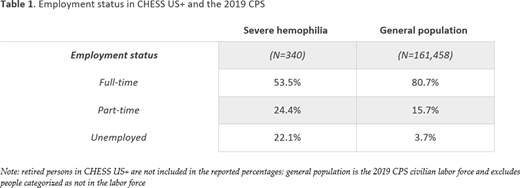INTRODUCTION
Severe hemophilia A (<1% normal FVIII activity) and B (<1% normal FIX activity) are congenital bleeding disorders characterized by uncontrolled bleeding, either spontaneously or in response to trauma or surgery.
Recent commentary has identified a number of patient-important and patient-relevant outcomes that have been understudied, namely the challenges faced by people living with hemophilia to participate in the labor force. The socio-economic impact of hemophilia is comparatively less well understood than clinical outcomes and therapy-related costs. Under-employment and under-utilization have long-term consequences to individuals' job prospects and psychosocial health, as well as an economic cost to the society.
The objective of the analysis is to compare labor market participation, among people with severe hemophilia from the US and the general population. This analysis draws on household data derived from the 2019 Current Population Survey (CPS), and on patient-reported data from a patient-centric study conducted in 2019 of people with severe hemophilia, in the US: the 'Cost of Severe Hemophilia Across the US: A Socioeconomic Survey' (CHESS US+).
METHODS
A patient-centric framework informed the design of CHESS US+ a retrospective (12 months prior to study enrollment), cross-sectional dataset of adults with severe hemophilia in the US. Conducted in 2019, the study used a patient-completed questionnaire to collect data on patient-relevant clinical, economic, and humanistic outcomes.
This analysis examines labor market participation (full-time, part-time, unemployed), and corresponding general population data derived from the 2019 Current Population Survey (CPS). Data on the general population were sourced from the 2019 CPS 'Employment status of the civilian noninstitutional population'. Persons 'not in the labor force' in the 2019 CPS and retired persons in CHESS US+ were not included in the analysis. We present data on the civilian labor force, in CHESS US+ and in the 2019 CPS. Results are presented as mean (standard deviation) or N (%).
RESULTS
Of 356 patients profiled in the CHESS US+ study, 97 (27%) had severe hemophilia B and 257 (73%) had severe hemophilia A. Mean age and weight (kg) of the cohort was 34.99 (12.15) and 85.71 (22.81), respectively.
The labor force participation rates of non-retired people with severe hemophilia in CHESS US+ (N = 340) and the general population (161,458) are described in Table 1. Examining aggregate data on employment status observed a higher proportion of people with severe hemophilia in part-time employment (24.4% vs. 15.7%).
Differences in the labor force participation of people living with severe hemophilia compared to the general population were most pronounced in the full-time employment rate and the unemployment rate. Compared to 80.7% of the general population (Table 1), only 53.5% of people with severe hemophilia in CHESS US+ had a full-time job. Moreover, the unemployment rate (Table 1) in the 2019 CPS compared with the rate observed in CHESS US+ (3.7% vs. 22.1%) provides a stark contrast in the employment experiences of people living with severe hemophilia relative to the general population.
CONCLUSIONS
This analysis of CHESS US+ illustrates the impact of severe hemophilia on labor force participation. People with severe hemophilia were more likely than the general population to be unemployed, or in part-time employment. A notable contrast was observed in the rate of full-time employment and unemployment, among the general population compared to people living with severe hemophilia. These data illustrate the need to quantify the impact of hemophilia using a holistic approach that considers the cost of involuntary illness-related part-time and unemployment.
Asghar:HCD Economics: Current Employment. Burke:HCD Economics: Current Employment; F. Hoffmann-La Roche Ltd: Consultancy; University of Chester: Current Employment. Misciattelli:Freeline: Current Employment, Current equity holder in publicly-traded company. Kar:Freeline: Current Employment, Current equity holder in publicly-traded company. Morgan:HCD Economics: Current Employment; uniQure: Consultancy. O'Hara:F. Hoffmann-La Roche Ltd: Consultancy; HCD Economics: Current Employment, Current equity holder in private company.
Author notes
Asterisk with author names denotes non-ASH members.


